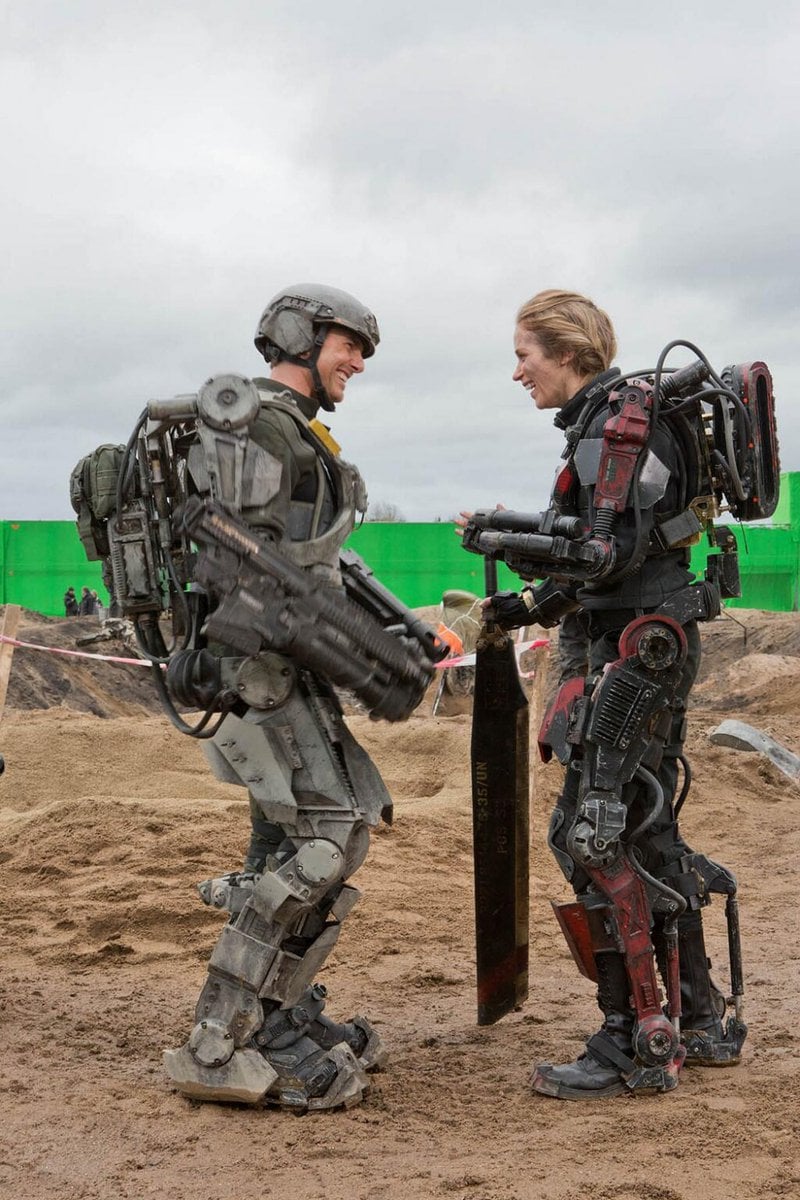Attach the ejector seat TO the helicopter blades so that they both eject and you get a cool propeller and can fly around and it can shoot lasers and stuff too.
I’ll get you next time, Gadget!
playing with legos be like
Just eject the damaged parts. Viola
Who brings a damaged viola to a warzone?
Now this is the kinda content I subscribe to
Who would win?
Two human skulls 💀💀
One twirly boi 🚁
Put some ERA on them skulls and you’re good
I like all the serious answers as if this was a real option.
Very credible
I think it’s the Apache helicopter that stops the rotors instantly on eject. No need for Mach 13. I know this graphic is a joke though, I just remembered this cool thing about the helicopter.
It’s the KA-50/52
How about this
https://en.m.wikipedia.org/wiki/Synchronization_gear#:~:text=A synchronization gear (also%20known,without%20bullets%20striking%20the%20blades.
Hear me out:
Seats that drop out of the bottom of the helicopter
Some Russian helicopters do this
How many of those are intentional?
F-104 did it first!
Did it work? Like are the test subjects still alive lol that sounds like rear decapitation city
I think the main problem with down-firing ejector seats was that they require a minimum altitude to work.
https://aviation.stackexchange.com/questions/1439/is-there-a-minimum-altitude-for-ejection-seats
I’m gonna turn to YouTube to see what I can find. This is pretty cool. Cars should have ejector seats too.
They’d definitely have a minimum altitude to work
“And what’s the minimum altitude?”
“Uh, one, I suppose.”
What about sideways?
I think they did it in a fast and furious movie, I’m not sure if that’s up to NCD standards.
That way, the pilots can get to the ground first and cushion the impact of the helo 👌
Just do a barrel roll while ejecting so you shoot up. Try not to hit your wingman with your copilot tho
Just detach the blades. You can always re-attach them when you’ve landed.
Works as a secret weapon too.
Oh you think I’ve been disarmed? *smirks* AMATEUR *violently ejects rotor blades in all directions*
I was just thinking the entire rotor assembly detaches and the helocopter falls away from it. But I think I like your idea better.
For ejection, the blades come off.
For combat, whole-rotor Beyblade.

What is this from? Looks pretty cool
Edge of Tomorrow. Fun movie.
Great for fans of Tom Cruise because he’s in it.
Great for people who hate Tom Cruise because you get to see him die over and over again!
The angle of the top of his feet/boots remind me of the Ron DeSantis boot thing - where he’s actually using a platform type setup to gain height.
I love jigsaw puzzles.
I doubt you’ll need to if you already had to eject.
That’s what the Ka-50 does
Sus. I watched AirWolf, and Magnum P.I. AND I’ve studied Leonardo di Vinci. Helicopters are next-gen tech and they don’t crash.
Ironically the helicopter casted as Airwolf did crash, killing all its occupants. 😞
Yeah that sucks, I didn’t mean to go there
Why not eject the rotor, Yu-Gi-Oh style
Why not just eject sideways?
Or blow up the rotor at the hub first.
Heck if accelerating to Mach 19 in about 2 meters is acceptable you could just disable the rotors and only experience an acceleration of less than Mach 1 in just a few meters.
What about that fancy thing that stops table saws when you touch them? Just get one of those and stop the rotors. I’m certain there’s no physical reason this wouldn’t work.
The energy will have to go somewhere, so the passengers can stand up with their arms stretched, and when the rotating energy reaches them they can jump out and they will start spinning and their arms will act as rotors keeping them in the air long enough to reach land safely. You just need to make sure there aren’t a lot of people on board because the energy will have to be divided on all of the passengers, if there isn’t enough for everyone, they will fall to their death.
When helicopters lose power they just fall. If the rotor head isn’t decapitated then when you get ejected sideways there’s s no zero chance you’ll be julienned on the way down.
It’s why the most (only version currently in operation) common method of helicopter ejection severs the head or blades while it’s still rotating so it/they spin off and hopefully away and then the seat rockets away.
Your first sentence is wrong. Stop explaining things you don’t understand yourself.
It’s a fact. Helicopters in general do not have the ability to glide to a landing, they can auto rotate if the rotor is still moving and has enough momentum. If the rotor stops or detaches helicopters fall…
“if the rotor stops” luckily in this universe we have conservation of motion so the rotor doesn’t typically stop in flight
Sure though, were it to detach the helicopter would fly like a brick
Hubris isn’t looked on Kindle in the aviation world.
Not common doesn’t mean not possible, we teach autorotation for a reason and it’s not because everything happens perfectly and every aircraft is perfectly maintained.
Helicopters crash constantly and just as an fyi auto rotation is falling with style and so is glide.
Like I said helicopters just fall, an aircraft in the most extreme engine failures tend to be able to glide effectively helicopters can never count on that luxury. So I dunno, since you agree maybe hop off the high horse and apologize.
I’m terribly sorry that I pointed out conservation of momentum in a thread where you want to imagine helicopter rotors can just stop. I know that reality is inconvenient.
Being wrong is the issue.
Rotors can add have seized, rotor failure is actually one of the more common modes of failure in a helicopter. Also notably I didn’t say it had to stop just that the rotor is no longer effective, like catastrophic blade loss.
You are failing to ask him a question: how does he know what he’s talking about?
His phrase was “we teach” which implies he’s an instructor. You should ask him if he is.
When helicopters lose power they just fall.
Any modern heli design will autorotate down. It’s not exactly gentle, but it works.
Autorotation relies on one main thing, air being forced past a freewheeling rotor… Air that is being forced past because you’re falling.
https://youtu.be/NLjFQJiJsZc?feature=shared
Notice the immediate loss of attitude? It’s because they’re falling, unlike planes which can generally glide after an engine failure.
Specifically we’re speaking about helicopter ejection which in most cases means total loss of power or control or both. The only known helicopter eje tion seat(to me at least) to operate currently in modern combat is the ka 50/52.
One like this one which happens to eject and notably falls like a stone.
The KA-50 and -52 destroy their rotors when the ejection seat fires, as shown in this simulation. That’s why the helicopter drops like a rock after the ejection seat fires - the blades can’t autorotate if they’re not attached.
Assuming the blades are still attached, the helicopter will autorotate down even if it is completely unpowered. It might lose some altitude initially, but like you said once the air is moving over the blades fast enough for them to spin they will do what they were designed to do.
One thing helicopters and planes have in common is that if they fail too close to the ground autorotation/gliding won’t help. Helis are generally more dangerous than planes for a lot of reasons, the biggest one being that they spend more time in the most dangerous phase of flight - landing.
It fails “the cool” factor so we rejected it.
Fire the seat forward toward the enemy aircraft that forced them to eject to allow them to steal it.
Next Mission Impossible flick sounds dope.
I think i heard one time that helicopters can jettison the rotor so you dont get chopped up
Unfortunately, that won’t stop the blades from spinning, meaning the danger isn’t averted.
You shear the blades so they shoot outwards. I couldn’t find an irl testing video, but here’s a render.
Now you have blades shooting away from the helicopter at a high speed which could kill someone.
Mainly just copium for the pilots. Helicopters aren’t like airplanes where you have glide time and altitude to decide what to do after something bad happens. If you watch fixed winged ejections there’s usually about 30 seconds to a min after something goes wrong before the pilot decides to bail. Helicopters go from everything being fine, to a debris field in seconds.
It’s more about altitude than the ability to glide. Helicopters can do what’s called Auto rotation, which means they actually can glide. If the blade seize up however, they can’t autorotate. Helicopters fly a lot lower than most airplanes though, so they can’t glide as far.
Autorotation is mostly copium as well.
Wow. I’d be nuts to fly one of those things. 6000 VVI sounds like suicide
With the collective firmly held down on the bottom stop, things happen very fast. The helicopter is descending in a hurry, as in 4,000 – 6,000 feet per minute. Do the math, if you are at 1,000 feet and the descent rate is 4,000 feet, you have one quarter or a minute – 15 seconds – to find a place to land.
Yeah, helicopters are the apex predators of soldiers and rich people. Even if you pull off the perfect autorotation, the glide ratio is still only a maximum of like 3:1.
I think I remember reading a report somewhere that more people have been killed by practicing autorotation than have actually pulled it off in the wild.
The Kamov does it.
The individual rotor blades are separated from the center with an explosive charge and their centrifugal motion carries them laterally away from the vehicle as the seat rockets straight up.
As a bonus, whoever was close enough to shoot you down is about to get at least one heavy steel javelin flung terrifyingly close to their direction at high speeds.
I’m assuming here that impact with a long range SAM is probably something you’re not about to eject from.
In cases like that I’d imagine you’d try and eject prior to being hit, though I don’t know enough to know how much warning time there is.
not much, considering how many of Ka-52s were shot down without pilots ejecting
Pretty sure someone was lying to ya
Several models of helicopters have ejectable blades, this article mentions a few, and has a diagram of the blade severing system.
Damn never would have expected that. Thanks for showing me something new!
Simple, just put the rotors on the bottom, problem solved!
Oh boy I love it when death is multiple choice!
- Fiery explosion
- Cuisinart of Doom
- Squeezing your brain into hips
- 9mm of lead therapy
- Other: __________













